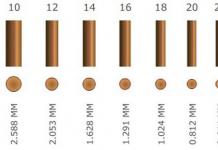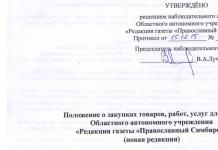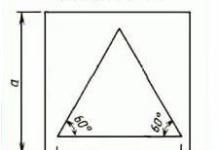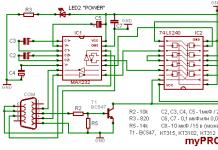At your request!
13. Solve the equation 3-4cos 2 x=0. Find the sum of its roots belonging to the interval .
Let's lower the cosine degree by the formula: 1+cos2α=2cos 2 α. We get an equivalent equation:
3-2(1+cos2x)=0 ⇒ 3-2-2cos2x=0 ⇒ -2cos2x=-1. We divide both sides of the equation by (-2) and get the simplest trigonometric equation:

14. Find b 5 geometric progression if b 4 =25 and b 6 =16.
Each member of the geometric progression, starting from the second, is equal to the arithmetic mean of the members adjacent to it:
(b n) 2 =b n-1 ∙b n+1 . We have (b 5) 2 =b 4 ∙b 6 ⇒ (b 5) 2 =25 16 ⇒ b 5 =±5 4 ⇒ b 5 =±20.
15. Find the derivative of the function: f(x)=tgx-ctgx.

16. Find the largest and smallest values of the function y(x)=x 2 -12x+27
on the segment.
To find the largest and smallest values of a function y=f(x) on the segment, you need to find the values of this function at the ends of the segment and at those critical points that belong to this segment, and then choose the largest and smallest from all the obtained values.
Let's find the values of the function at x=3 and at x=7, i.e. at the ends of the segment.
y(3)=3 2 -12∙3+27 =9-36+27=0;
y(7)=7 2 -12∙7+27 =49-84+27=-84+76=-8.
Find the derivative of this function: y'(x)=(x 2 -12x+27)' =2x-12=2(x-6); the critical point x=6 belongs to the given interval. Find the value of the function at x=6.
y(6)=6 2 -12∙6+27 =36-72+27=-72+63=-9. And now we choose from the three obtained values: 0; -8 and -9 are the largest and smallest: at the most. =0; at hiring =-9.
17. Find the general form of antiderivatives for the function:
This interval is the domain of definition of this function. Answers should start with F(x), not f(x) because we are looking for an antiderivative. By definition, the function F(x) is antiderivative for the function f(x) if the equality holds: F’(x)=f(x). So you can just find derivatives of the proposed answers until you get this function. A strict solution is the calculation of the integral of a given function. We apply formulas:

19. Compose the equation of a straight line containing the median BD of triangle ABC if its vertices are A(-6; 2), B(6; 6) C(2; -6).
To compile the equation of a straight line, you need to know the coordinates of 2 points of this straight line, and we only know the coordinates of point B. Since the median BD divides the opposite side in half, the point D is the midpoint of the segment AC. The midpoints of a segment are the half-sums of the corresponding coordinates of the ends of the segment. Let's find the coordinates of point D.

20. Calculate:

24. The area of a regular triangle at the base of a right prism is
This problem is the inverse of problem 24 from option 0021.

25. Find a pattern and insert the missing number: 1; 4; 9; sixteen; …
Obviously this number 25 , since we are given a sequence of squares of natural numbers:
1 2 ; 2 2 ; 3 2 ; 4 2 ; 5 2 ; …
Good luck and success to all!
To successfully solve trigonometric equations convenient to use reduction method to previously solved problems. Let's see what is the essence of this method?
In any proposed problem, you need to see the previously solved problem, and then, using successive equivalent transformations, try to reduce the problem given to you to a simpler one.
So, when solving trigonometric equations, they usually make up some finite sequence of equivalent equations, the last link of which is an equation with an obvious solution. It is only important to remember that if the skills for solving the simplest trigonometric equations are not formed, then solving more complex equations will be difficult and ineffective.
In addition, when solving trigonometric equations, you should never forget about the possibility of the existence of several solutions.
Example 1. Find the number of roots of the equation cos x = -1/2 on the interval.
Solution:
I way. Let's plot the graphs of the functions y = cos x and y = -1/2 and find the number of their common points on the interval (Fig. 1).
Since the graphs of functions have two common points on the interval, the equation contains two roots on this interval.
II way. Using the trigonometric circle (Fig. 2), we find out the number of points belonging to the interval in which cos x = -1/2. The figure shows that the equation has two roots. 
III way. Using the formula of the roots of the trigonometric equation, we solve the equation cos x = -1/2.
x = ± arccos (-1/2) + 2πk, k is an integer (k € Z);
x = ± (π – arccos 1/2) + 2πk, k is an integer (k € Z);
x = ± (π – π/3) + 2πk, k is an integer (k € Z);
x = ± 2π/3 + 2πk, k is an integer (k ∈ Z).
The roots 2π/3 and -2π/3 + 2π belong to the interval, k is an integer. Thus, the equation has two roots on a given interval.
Answer: 2.
In the future, trigonometric equations will be solved by one of the proposed methods, which in many cases does not exclude the use of other methods.
Example 2. Find the number of solutions to the equation tg (x + π/4) = 1 on the interval [-2π; 2π].
Solution:
Using the formula of the roots of the trigonometric equation, we get:
x + π/4 = arctan 1 + πk, k is an integer (k € Z);
x + π/4 = π/4 + πk, k is an integer (k € Z);
x = πk, k is an integer (k € Z);
The interval [-2π; 2π] belong to the numbers -2π; -π; 0; π; 2π. So, the equation has five roots on a given interval.
Answer: 5.
Example 3. Find the number of roots of the equation cos 2 x + sin x cos x = 1 on the interval [-π; π].
Solution:
Since 1 = sin 2 x + cos 2 x (basic trigonometric identity), the original equation becomes:
cos 2 x + sin x cos x = sin 2 x + cos 2 x;
sin 2 x - sin x cos x \u003d 0;
sin x(sin x - cos x) = 0. The product is equal to zero, which means that at least one of the factors must be equal to zero, therefore:
sin x \u003d 0 or sin x - cos x \u003d 0.
Since the value of the variable, at which cos x = 0, are not the roots of the second equation (the sine and cosine of the same number cannot be equal to zero at the same time), then we divide both parts of the second equation by cos x:
sin x = 0 or sin x / cos x - 1 = 0.
In the second equation, we use the fact that tg x = sin x / cos x, then:
sin x = 0 or tg x = 1. Using formulas, we have:
x = πk or x = π/4 + πk, k is an integer (k € Z).
From the first series of roots to the interval [-π; π] belong to the numbers -π; 0; π. From the second series: (π/4 – π) and π/4.
Thus, the five roots of the original equation belong to the interval [-π; π].
Answer: 5.
Example 4. Find the sum of the roots of the equation tg 2 x + сtg 2 x + 3tg x + 3сtgx + 4 = 0 on the interval [-π; 1.1π].
Solution:
Let's rewrite the equation in the following form:
tg 2 x + сtg 2 x + 3(tg x + сtgx) + 4 = 0 and make a change.
Let tg x + сtgx = a. Let's square both sides of the equation:
(tg x + сtg x) 2 = a 2 . Let's expand the brackets:
tg 2 x + 2tg x ctgx + ctg 2 x = a 2 .
Since tg x сtgx \u003d 1, then tg 2 x + 2 + сtg 2 x \u003d a 2, which means
tg 2 x + сtg 2 x \u003d a 2 - 2.
Now the original equation looks like:
a 2 - 2 + 3a + 4 = 0;
a 2 + 3a + 2 = 0. Using Vieta's theorem, we get that a = -1 or a = -2.
Making the reverse substitution, we have:
tg x + сtgx = -1 or tg x + сtgx = -2. Let's solve the obtained equations.
tgx + 1/tgx = -1 or tgx + 1/tgx = -2.
By the property of two mutually reciprocal numbers, we determine that the first equation has no roots, and from the second equation we have:
tg x = -1, i.e. x = -π/4 + πk, k is an integer (k ∈ Z).
The interval [-π; 1,1π] the roots belong: -π/4; -π/4 + π. Their sum:
-π/4 + (-π/4 + π) = -π/2 + π = π/2.
Answer: π/2.
Example 5. Find the arithmetic mean of the roots of the equation sin 3x + sin x = sin 2x on the interval [-π; 0.5π].
Solution:
We use the formula sin α + sin β = 2sin ((α + β)/2) cos ((α - β)/2), then
sin 3x + sin x = 2sin ((3x + x)/2) cos ((3x – x)/2) = 2sin 2x cos x and the equation becomes
2sin 2x cos x = sin 2x;
2sin 2x cos x - sin 2x \u003d 0. We take out the common factor sin 2x out of brackets
sin 2x(2cos x - 1) = 0. Let's solve the resulting equation:
sin 2x \u003d 0 or 2cos x - 1 \u003d 0; 
sin 2x = 0 or cos x = 1/2;
2x = πk or x = ±π/3 + 2πk, k is an integer (k € Z).
Thus we have roots
x = πk/2, x = π/3 + 2πk, x = -π/3 + 2πk, k is an integer (k € Z).
The interval [-π; 0.5π] belong to the roots -π; -π/2; 0; π/2 (from the first series of roots); π/3 (from the second series); -π/3 (from the third series). Their arithmetic mean is:
(-π - π/2 + 0 + π/2 + π/3 - π/3)/6 = -π/6.
Answer: -π/6.
Example 6. Find the number of roots of the equation sin x + cos x = 0 on the interval [-1.25π; 2π].
Solution:
This equation is a homogeneous equation of the first degree. Let's divide both its parts by cosx (the value of the variable, at which cos x = 0, are not the roots of this equation, since the sine and cosine of the same number cannot be equal to zero at the same time). The original equation looks like:
x = -π/4 + πk, k is an integer (k ∈ Z).
Gap [-1.25π; 2π] have roots -π/4; (-π/4 + π); and (-π/4 + 2π).
Thus, three roots of the equation belong to the given interval.
Answer: 3.
Learn to do the most important thing - to clearly present a plan for solving the problem, and then any trigonometric equation will be on your shoulder.
Do you have any questions? Don't know how to solve trigonometric equations?
To get the help of a tutor - register.
site, with full or partial copying of the material, a link to the source is required.
To successfully solve trigonometric equations convenient to use reduction method to previously solved problems. Let's see what is the essence of this method?
In any proposed problem, you need to see the previously solved problem, and then, using successive equivalent transformations, try to reduce the problem given to you to a simpler one.
So, when solving trigonometric equations, they usually make up some finite sequence of equivalent equations, the last link of which is an equation with an obvious solution. It is only important to remember that if the skills for solving the simplest trigonometric equations are not formed, then solving more complex equations will be difficult and ineffective.
In addition, when solving trigonometric equations, you should never forget about the possibility of the existence of several solutions.
Example 1. Find the number of roots of the equation cos x = -1/2 on the interval.
Solution:
I way. Let's plot the graphs of the functions y = cos x and y = -1/2 and find the number of their common points on the interval (Fig. 1).
Since the graphs of functions have two common points on the interval, the equation contains two roots on this interval.
II way. Using the trigonometric circle (Fig. 2), we find out the number of points belonging to the interval in which cos x = -1/2. The figure shows that the equation has two roots. 
III way. Using the formula of the roots of the trigonometric equation, we solve the equation cos x = -1/2.
x = ± arccos (-1/2) + 2πk, k is an integer (k € Z);
x = ± (π – arccos 1/2) + 2πk, k is an integer (k € Z);
x = ± (π – π/3) + 2πk, k is an integer (k € Z);
x = ± 2π/3 + 2πk, k is an integer (k ∈ Z).
The roots 2π/3 and -2π/3 + 2π belong to the interval, k is an integer. Thus, the equation has two roots on a given interval.
Answer: 2.
In the future, trigonometric equations will be solved by one of the proposed methods, which in many cases does not exclude the use of other methods.
Example 2. Find the number of solutions to the equation tg (x + π/4) = 1 on the interval [-2π; 2π].
Solution:
Using the formula of the roots of the trigonometric equation, we get:
x + π/4 = arctan 1 + πk, k is an integer (k € Z);
x + π/4 = π/4 + πk, k is an integer (k € Z);
x = πk, k is an integer (k € Z);
The interval [-2π; 2π] belong to the numbers -2π; -π; 0; π; 2π. So, the equation has five roots on a given interval.
Answer: 5.
Example 3. Find the number of roots of the equation cos 2 x + sin x cos x = 1 on the interval [-π; π].
Solution:
Since 1 = sin 2 x + cos 2 x (basic trigonometric identity), the original equation becomes:
cos 2 x + sin x cos x = sin 2 x + cos 2 x;
sin 2 x - sin x cos x \u003d 0;
sin x(sin x - cos x) = 0. The product is equal to zero, which means that at least one of the factors must be equal to zero, therefore:
sin x \u003d 0 or sin x - cos x \u003d 0.
Since the value of the variable, at which cos x = 0, are not the roots of the second equation (the sine and cosine of the same number cannot be equal to zero at the same time), then we divide both parts of the second equation by cos x:
sin x = 0 or sin x / cos x - 1 = 0.
In the second equation, we use the fact that tg x = sin x / cos x, then:
sin x = 0 or tg x = 1. Using formulas, we have:
x = πk or x = π/4 + πk, k is an integer (k € Z).
From the first series of roots to the interval [-π; π] belong to the numbers -π; 0; π. From the second series: (π/4 – π) and π/4.
Thus, the five roots of the original equation belong to the interval [-π; π].
Answer: 5.
Example 4. Find the sum of the roots of the equation tg 2 x + сtg 2 x + 3tg x + 3сtgx + 4 = 0 on the interval [-π; 1.1π].
Solution:
Let's rewrite the equation in the following form:
tg 2 x + сtg 2 x + 3(tg x + сtgx) + 4 = 0 and make a change.
Let tg x + сtgx = a. Let's square both sides of the equation:
(tg x + сtg x) 2 = a 2 . Let's expand the brackets:
tg 2 x + 2tg x ctgx + ctg 2 x = a 2 .
Since tg x сtgx \u003d 1, then tg 2 x + 2 + сtg 2 x \u003d a 2, which means
tg 2 x + сtg 2 x \u003d a 2 - 2.
Now the original equation looks like:
a 2 - 2 + 3a + 4 = 0;
a 2 + 3a + 2 = 0. Using Vieta's theorem, we get that a = -1 or a = -2.
Making the reverse substitution, we have:
tg x + сtgx = -1 or tg x + сtgx = -2. Let's solve the obtained equations.
tgx + 1/tgx = -1 or tgx + 1/tgx = -2.
By the property of two mutually reciprocal numbers, we determine that the first equation has no roots, and from the second equation we have:
tg x = -1, i.e. x = -π/4 + πk, k is an integer (k ∈ Z).
The interval [-π; 1,1π] the roots belong: -π/4; -π/4 + π. Their sum:
-π/4 + (-π/4 + π) = -π/2 + π = π/2.
Answer: π/2.
Example 5. Find the arithmetic mean of the roots of the equation sin 3x + sin x = sin 2x on the interval [-π; 0.5π].
Solution:
We use the formula sin α + sin β = 2sin ((α + β)/2) cos ((α - β)/2), then
sin 3x + sin x = 2sin ((3x + x)/2) cos ((3x – x)/2) = 2sin 2x cos x and the equation becomes
2sin 2x cos x = sin 2x;
2sin 2x cos x - sin 2x \u003d 0. We take out the common factor sin 2x out of brackets
sin 2x(2cos x - 1) = 0. Let's solve the resulting equation:
sin 2x \u003d 0 or 2cos x - 1 \u003d 0; 
sin 2x = 0 or cos x = 1/2;
2x = πk or x = ±π/3 + 2πk, k is an integer (k € Z).
Thus we have roots
x = πk/2, x = π/3 + 2πk, x = -π/3 + 2πk, k is an integer (k € Z).
The interval [-π; 0.5π] belong to the roots -π; -π/2; 0; π/2 (from the first series of roots); π/3 (from the second series); -π/3 (from the third series). Their arithmetic mean is:
(-π - π/2 + 0 + π/2 + π/3 - π/3)/6 = -π/6.
Answer: -π/6.
Example 6. Find the number of roots of the equation sin x + cos x = 0 on the interval [-1.25π; 2π].
Solution:
This equation is a homogeneous equation of the first degree. Let's divide both its parts by cosx (the value of the variable, at which cos x = 0, are not the roots of this equation, since the sine and cosine of the same number cannot be equal to zero at the same time). The original equation looks like:
x = -π/4 + πk, k is an integer (k ∈ Z).
Gap [-1.25π; 2π] have roots -π/4; (-π/4 + π); and (-π/4 + 2π).
Thus, three roots of the equation belong to the given interval.
Answer: 3.
Learn to do the most important thing - to clearly present a plan for solving the problem, and then any trigonometric equation will be on your shoulder.
Do you have any questions? Don't know how to solve trigonometric equations?
To get help from a tutor -.
blog.site, with full or partial copying of the material, a link to the source is required.



































